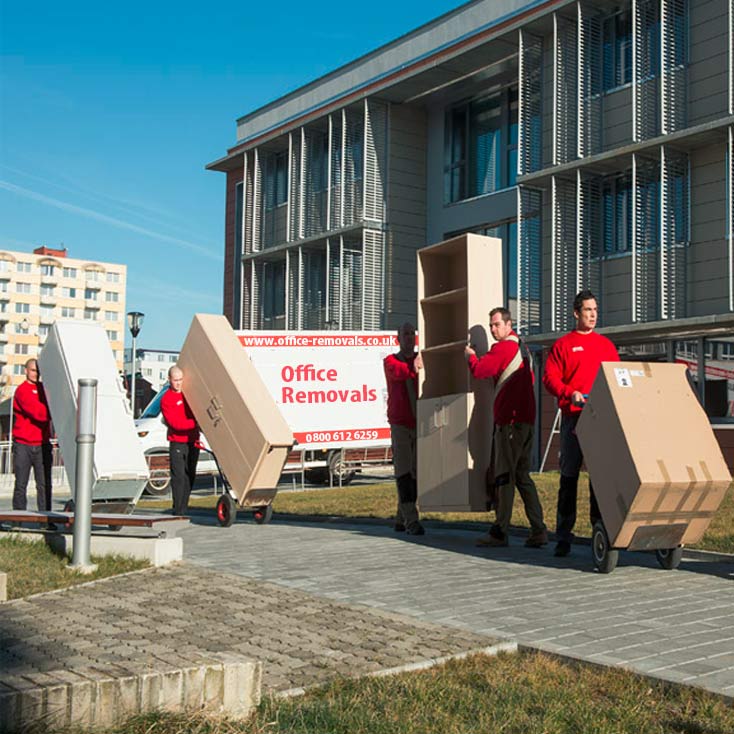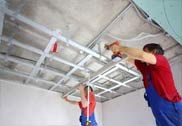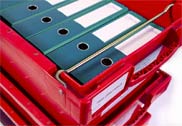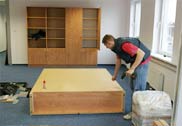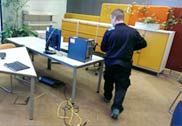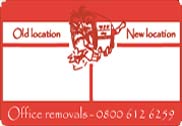-
Labelling methods, free labels, sign-age, floor plans, distribution and placing
Waste Electrical and Electronic Equipment Recycling
One of the most specialized areas of the waste and recycling industry is the recycling of the WEEE. This sector is witnessing a rapid growth, due largely to the original directives of the WEEE in the UK as given in 2006. This stipulated some requirements for people who want to recover, reuse, recycle and treat the WEEE. The 2013 regulations of the Waste Electric and Electronic Equipment also known as WEEE was made a law in 2014 in the UK, replacing the regulations of 2006. This new law also supersedes the 2012/19/EU directives on issues of the WEEE, recasting the 2002/96/EC previous directives. The provisions of the regulations also maps out the array of products to be considered under it, starting from the 1st day of January 2019.
If you want to get more information about the 2013 WEEE regulations, check the pdf link to the eternal website of the government guidance notes by the innovation and skills department.
The estimate is that houses and companies in the UK discard about 2 million tons of WEEE in the UK every other year. This includes most of the products that work with battery or a plug. The categorization of the products under the WEEE as outlined in the 1st and 2nd schedules of the given regulations involve about 10 different product lines, and they include;
 The large household appliances which comprises of the dishwashers, washing machines, microwaves, cookers and fridges
The large household appliances which comprises of the dishwashers, washing machines, microwaves, cookers and fridges- The small household appliances include the cooks and toasters, irons, and the vacuum cleaners.
- Telecommunications and IT equipment include telephones, copying equipments of all types, personal computers and pocket calculators.
- The consumer equipments comprise of the musical instruments, camcorders, HiFi equipment, televisions and radios.
- The lighting equipments include lamps of high intensive discharge, compact and straight fluorescent tubes.
- Electrical and electronic tools include electric lawnmowers, sewing machines, saws and drills.
- The leisure, toy and sports equipments on their part comprise of the running machines, game consoles, and electric trains.
- Medical devices include all the non infected cardiology equipment, medical freezers, analyzers, and dialysis machines.
- Control and monitoring equipment take care of the heating regulators, thermostats, and smoke directors.
- Automatic dispensers include the money dispensers and dispensers of hot drinks
Come January 2013, the scope of this regulation would be extended to include some other categories of electronic and electric equipment.
Electronic equipment recycling services
Our major asset recovery and IT disposal services provided in London, Birmingham, Glasgow and other areas, are meant to get the highest amount of value from old IT equipment for all our clients. And also to ensure that environmental sustainability is enhanced while disposing off computer equipment when they cannot be reused again.
The entire disposal process is completely managed by our WEEE recycling company. This starts from the logistics and planning, the technical processing, the secure destruction of data, the assessment and testing of it for resale and to the recycling of the unusable ones.
WEEE recycling is a part of our office removals services. We ensure that all the computers to be disposed receive proper individual management, tracking and item reporting through the services of our in-house team for IT disposal and assets management. The entire process involves several stages like the testing of electrical safety, to ensure that they can safely connect to power sources and the diagnostics that checks how functional different parts and components are, and the final eradication of data with software that is approved by the CESG.
Through the technical processing skills that has never been matched by any, we are able to conduct the disposal, recycling and management of thousands of IT equipment per year across the entire UK including electronic waste recycling in Leeds, Nottingham, Edinburgh, Leicester and other areas. By so doing we return millions of dollars to our clients. We always offer detailed office move planning regardless of the scope of the job.
WEEE collection services
Every firm no matter how large or small will always have the need to recycle some amount of IT from time to time. It is important that IT firms that have some amount of Waste Electronic and Electrical Equipment to recycle should do this in the most appropriate manner. When you want to recycle your IT in an economic and efficient manner, then you must adhere to the environmental and security legislation, and this is what we do for you when you hire our Waste Electrical and Electronic Equipment recycling company. We also provide office moving crates in advance, so your IT department can pack your IT equipment on their own. But if you don't know how to pack a PC, we recommend to leave both packing and removal to our team. We offer comprehensive removal and recycling services.
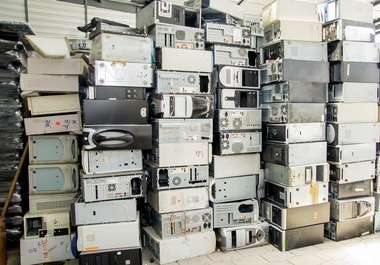 We use the Tech4Recycle Service RDC to recover all computers that have been redundant, so as to destroy all the confidential and unsecured data, and do the recycling of the IT equipment the approved way. While doing this, we track and report all the IT equipment and computers.
We use the Tech4Recycle Service RDC to recover all computers that have been redundant, so as to destroy all the confidential and unsecured data, and do the recycling of the IT equipment the approved way. While doing this, we track and report all the IT equipment and computers.
Our UK WEEE disposal services include offering of value added services when it comes to the disposal of these unneeded IT equipment. When you use our IT recycling services in London, you should be sure of your business risks because the firm that is handling your IT disposal will make use of all the legal systems specified for the handling of the equipment, through an environmentally conscious and safe process with the assurance of quality. Compare office moving costs including recycling services and make your WEEE recycling as cheap as possible.
Computer and IT reuse and redeployment
This is one of the best processes you can ever use when you have equipment that will need a simple refreshing in its product circle and still catch up with the business requirements. This involves refurbishing existing furniture and redeploying same back into the organization.
We offer computer moving services that will enable firms to have their IT equipment picked from one location, refurbished, upgraded properly if there is any need for this and reconfigured for onward redeployment for use in the same site of some other site. When you choose the computers to be refurbished in your organization, we will process them in compliance to the provisions of IT redeployment tasks. Check our IT equipment reuse and redeployment services. We have branches in most regions, including Coventry, Oxford, York and other places. If you are wondering how to recycle electronic waste, be it commercial electronic, or household appliances, contact us today and request our free quote and check costs of WEEE recycling services in your area.
There are some processes that all equipment for redeployment must go through. These must be processes agreed upon with the client, so that all the IT assets picked up for redeployment are acceptable. When the items have been adjudged appropriate for redeployment through our tests, then they will need an upgrading or downgrading in compliance with the specifications for IT redeployment. There may also be cases of internal and external refurbishments, re asset and image builds. With these services, clients will have the option to achieve the redeployment of equipment with different amounts of cost and refurbishment.
If you are looking for commercial removal solutions, use our contact form the request Wigan office movers quotes for your local relocation.
Electronic waste disposal and recycling company
More than 40% of the entire WEE equipment is made up of large household appliances like washing machines and fridges. However, some other equipments like the IT equipments, TVs, small household appliances like hair dryers and kettles, digital watches, electrical tools, medical tolls and electrical toys also take a chunk of the percentage of the WEE equipment.
Each of these items is designed with varieties of materials. for instance if you check an average television, you will realize that it is made up of 6% metal and about 50% glass, but when you look at a cookers, you will witness about 6% glass and 80% metal. In these products, you will also encounter some other materials like precious metals, ceramics and plastics.
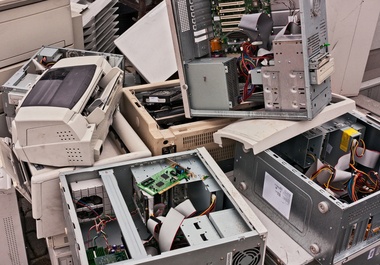 Because of the nature of these equipments, where they contain a mixture of products and materials, including hazardous ones in a complicated manner, like the flame retardants, mercury, lead, cadmium and arsenic, some major risks are therefore posed by the WEE recycling which will definitely need some caution to manage. For instance, during the processing, if one is exposed to some substances like phosphorus and lead from cathode ray tubes and mercury from fluorescent tubes, this could be dangerous to his or her health and the environment at large.
Because of the nature of these equipments, where they contain a mixture of products and materials, including hazardous ones in a complicated manner, like the flame retardants, mercury, lead, cadmium and arsenic, some major risks are therefore posed by the WEE recycling which will definitely need some caution to manage. For instance, during the processing, if one is exposed to some substances like phosphorus and lead from cathode ray tubes and mercury from fluorescent tubes, this could be dangerous to his or her health and the environment at large.
So, if the world is stressing the need to ensure that the exposure to mercury and lead is controlled, then the control of exposure to some other hazardous items and substances should also be stressed.
In treating the WEEE, the exact methods used may vary, depending on the amount of such substance that is involved in the product and the type of technology used for the treatment. Large scale shredding may be the most used by some treatment facilities, while some others may resort to disassembly in the automated, normal or combined methods.
When the items are to be disassembled, the facilities used for this must be in compliance with the guidance on Waste Electrical and Electronic Equipment (WEEE) and the best available treatment recovery and recycling techniques (BATRRT) from the DEFRA. The document provides insight on the recovery, recycling and treatment standards to adhere to in handling the WEEE. This is where you will see the outline to use when you want to remove certain components and substances from some items.
However, if the items or equipment are to be shredded, then there may not be the need to remove or separate these components and substances. However, this simply depends on the type of technology used, coupled with the size of the item, the components and the technology too; though some cases may demand that some hazardous substances and components be removed on time so that health and safety risks, coupled with damage to the equipments are avoided.
The action programs on waste resources under the (WRAP) acronym have come up with some good practice guidance for the collection and processing of these WEE online. This involves some sections that treat the best policies for treatments, health and safety procedures, and policies for the WEEE. This is given for the AATFs audience and for all the companies that are into waste management. This will be very beneficial to the inspectors too.
We cover entire UK offering business removals Blackpool, Chester, Newcastle and other places.
Guidance on recycling components and substances
The summer and notes below were largely taken from the document on the treatment of the Waste Electrical and Electronic Equipment (WEEE) and Best Available Treatment Recovery and Recycling Techniques (BATRRT) from the DEFRA.
- Fluids
You will find more of these fluids in the cooling and heating appliances like the freezers and fridges and some of the oil field radiators. According to the directive of the WEEE, you have to ensure that all fluids are completely removed. You have to remove them before you crush or shred the products. If the appliances have refrigerants (this is mostly for freezers and fridges), you have to realize that majority of the refrigerators that make it to the waste stream are normally more than 15 years of age. What this means is that they would likely contain some ozone depleting substances like the HCFCs and the CFCs. However, those that were manufactured from 1994 downwards will not have this.
If any freezer or fridge is identified to have some ammonia content, you have to ensure that the ammonia is extracted from the freezer and moved into a container that is suitable enough for its disposal. The ammonia substance does not only pose an explosion and fire risk; it is also hazardous to both human and environmental health. It’s always better to hire professional freezer recycling company and avoid lots of problems with recycling fridge or freezer. - Capacitors with some amount of polychlorinated biphenyls or PCB
Iit is known in history that most transformers and capacitors with other electric equipments were manufactured with some amount of pcbs. However, there was a ban on the use of these in open applications in 1972. So, since 1986, they have not been used in manufacturing any new appliances and equipments. However, already installed plants after the 1986 regulations were given the grace to stay out their working life. So, we have to assume that all the capacitors made before 1976 have the pcbs as one of the constituent materials. But it is also good to note that the chance that capacitors in plants that are less than 20 years old have pcbs in them is very rare. The regulation also states that the use of pcbs were to be phased out by the year 2000. If you need more guidance on matters relating to capacitors with the pcbs, you have to check any page that goes by the title “Do you know how to work safely with PCBs? Alternatively hire pcbs disposal services and leave it to professionals. - Recycling of components containing mercury
 Mobile phones, fluorescent lamps, data transmission and medical equipment contain some amount of mercury. The use of this in electrical and electronic equipment was banned in 2006, so this has automatically declined within the past years. With the exception of battery, you will find other items containing mercury mostly in circuit boards. So, when you remove the circuit board, you would have removed the mercury content in materials like the switches.
Mobile phones, fluorescent lamps, data transmission and medical equipment contain some amount of mercury. The use of this in electrical and electronic equipment was banned in 2006, so this has automatically declined within the past years. With the exception of battery, you will find other items containing mercury mostly in circuit boards. So, when you remove the circuit board, you would have removed the mercury content in materials like the switches.
There is an increase in the non-CRT flat panel screens that enter the waste stream on a daily basis. This is exemplified in the plasma screens, desk top monitor and laptop screens and LCD TV screens. Because of this, they will require specialist treatments. The number of sold flat screen TVs in 2010 was estimated to be about 9 million. The switch to the led backlight screen which has been in place since 2009 has not been fast and aggressive enough, and this has made it possible for the continued use of the mercury containing backlights. By 2017, the number of flat panel displays expected in the waste stream is up to 145,000 tones. One of the major problems encountered in the process of treating and recovering the flat screen panels at the end of the work life of the laptops, desktops and LCDs is the presence of the fluorescent backlights that are meant to illuminate them from behind. This is not same with the plasma screens.
According to the manufacturers of these devices, an average of 3.5mg of mercury is used for every backlight, and a 37 inch television will have at least 18 or more of these lights. Because of these, the best method of treatment for now is to remove the backlights that contain the mercury with hand and also separate other materials before shredding. The problem with this is that it will also present some safety and health implications, with a high cost of labor for mercury removal and disposal. Contact us to get instant quote on mercury waste managing and disposal. Recycling of mercury is a part of our laboratory relocation services. - Tone cartridges, color toner and liquid and paste
These are mostly present in photocopiers, fax machines and printers. The best way to recycle these is to remove them while they are still intact, so that the tones will not disperse when shredding. When removed, they should be stored in containers that are properly labeled. - Asbestos wastes recycling services
Some old appliances like the electric irons, toasters and electric coffee pots have these. Some of the olden electric heaters and some other items also came with some asbestos contents. This was used because of its resistance to heat. However, asbestos is banned for all modern appliances. But when you are operating with treatment facilities, you should look out for items that may contain asbestos. Some of the items that may be more than 20 years old may have some amount of asbestos in them.
This is why the operators must examine all items properly and handle carefully if found to contain this. Before you could handle any items that may contain this, you must undergo some training on safe system of work and risk assessment. The entire process is to be fashioned in a way that asbestos containing materials are identified on time. The work must never go on without compliance to the Control of Asbestos at Work Regulations 2006. We have years of experience in providing asbestos recycling and disposal services in London, Birmingham, including complex office removals Liverpool solutions, as well as in other areas. - Lead, phosphorus pentachloride and other substances
When the glass is being processed to take out the fluorescent coating, the phosphorus pentachloride, lead and some other hazardous substances should also be liberated. - Items with refractory ceramic fibers
this is mostly used in kiln, heater and furnace linings. The respirable RCFs are under the category 2 carcinogen classification. These however, may be used in the manufacturing of appliances for building heating and domestic use. However, the choice of the insulation materials for the domestic electrical appliances will base more on mineral wools and lesser on RCFs. Whenever appliances are suspected to contain RCFs, they should be examined to ascertain this. If the answer to this is yes, then they must be removed with the appropriate controls in place.
Items with substances that are radioactive - these could be found in many equipment used in commercial settings. These will include the old trim phones, radium luminesced dials, and static eliminators, fill level detectors and in some smoke dictators too.
Hazards of WEEE recycling
- Machinery safety
Some of the factory plants for the recycling of the WEEE work with different types of machinery or equipment for the treatment of the materials, during baling, compacting, conveying, grinding, palletizing and crushing. All these have their machines. - MSDs
Dduring annual handling - this involves some of the WEE items like the white goods, and they can be very heavy. Even the TVs could weigh up to 30kg. - WRULDS
From the removal of wiring looms through repetitive movements.
Abrasion Risks And Cuts - this may occur during the use of knives to take out the coatings used or anti-break in fluorescent lamps, or from sharp edges on different items during dismantling or when broken. - WEE items stacking
This is more on the white goods. Be sure of the ability of the stack. The rule is that it should not be more than times 3 of the least base dimension. - Electrical safety
You have to consider issues of safety if there is any form of refurbishment being done. - Risks of fire and explosion
This is due to ammonia and hydrocarbons in freezers and fridges, coupled with polystyrene. For instance, you will find polystyrene used to insulate freezers and fridges and for packing materials. Again, the pentane in the polystyrene is a flammable material. In terms of batteries, they should be removed from the WEE items and stored in well labeled containers, with full consciousness of the fact that they can easily catch fire. - IT data destruction services
We have lots of solutions and services to help you with the destruction of data that are marked protectively. We do this in full compliance to the provisions of data protection laws and regulations, according to the security policies and standards set by the government for the destruction of data. We destroy the data through a controlled process that will see each individual date and the destruction process tracked by members of our team through our management system. - Eradication of data with certification
In line with our core processing tasks, we make use of the approved software to wipe all data in items that bear data. When we are through with this, safety and functionality checks are conducted, and when the data holding items are certified okay, they are resold for future use, while some amount of residual income is generated. - Degaussing
In cases where the reuse of magnetic media and hard disk drives is not applicable, they are subjected through the process of degaussing. Through this process, the tools destroy every data in them and make them non-reusable. - Disintegration
This is also known as shredding. When it is not possible to wipe data away from the hard disk drives and other devices that bear data, and the equipment cannot also be reused, then disintegration, destruction or shredding is the best option.
 WEEE recycling services
WEEE recycling services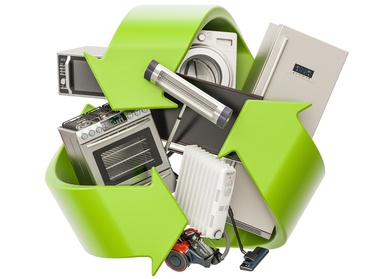 The large household appliances which comprises of the dishwashers, washing machines, microwaves, cookers and fridges
The large household appliances which comprises of the dishwashers, washing machines, microwaves, cookers and fridges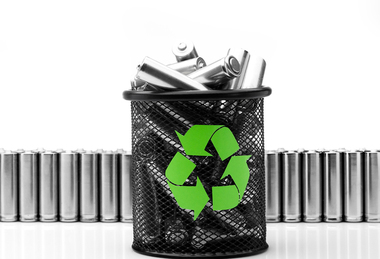 Mobile phones, fluorescent lamps, data transmission and medical equipment contain some amount of mercury. The use of this in electrical and electronic equipment was banned in 2006, so this has automatically declined within the past years. With the exception of battery, you will find other items containing mercury mostly in circuit boards. So, when you remove the circuit board, you would have removed the mercury content in materials like the switches.
Mobile phones, fluorescent lamps, data transmission and medical equipment contain some amount of mercury. The use of this in electrical and electronic equipment was banned in 2006, so this has automatically declined within the past years. With the exception of battery, you will find other items containing mercury mostly in circuit boards. So, when you remove the circuit board, you would have removed the mercury content in materials like the switches.